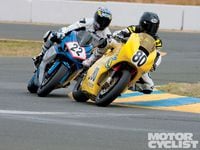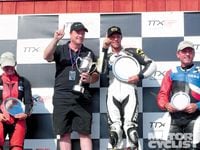This year has been hectic for Lightning Electric Motorcycles founder Richard Hatfield. The Lightning race team, with rider Michael Barnes, just clinched the inaugural American TTXGP championship. In addition, Hatfield's team competed in the Pikes Peak hillclimb, the FIM e-Power support race during the USGP at Laguna Seca, and at press time was preparing for the BUB Speed Trials at Bonneville. His goals on the hallowed salt flats are to surpass the Lightning's previous 166-mph run, break the current 176-mph electric-bike record and, ultimately, the 200-mph barrier. Why the frantic racing schedule, chasing glory in multiple disciplines? Hatfield is very simply a man on a mission. "We're trying to push electric-motorcycle technology to parity with gas-powered motorcycles."
Hatfield's concisely worded objective belies the colossal effort that entails. In the late 19th century Ferdinand Porsche debuted an electric automobile, but it wasn't until the 21st century that the green movement, technical advances in batteries and the global economy conspired to finally set the stage for electric vehicles' success. Hatfield sees racing as the path to push EV development over the top, hence his efforts to showcase the technology at every opportunity.
The Lightning e-racer is powered by a three-phase AC motor rescued from a doomed General Motors EV-1. Batteries are A123s, which Hatfield described as "flawless" in their operation. He had development help along the way from professionals such as Ray Abrams at A&A; Racing, who constructed the Lightning's chromoly-steel trellis frame, and RaceTech's Paul Thede, who tamed its handling. Hatfield has his own decades of experience, too, having raced such esoteric vehicles as a Wankel-engined Mazda 13B and a 320R Honda-powered Le Mans racecar running on alcohol. As Hatfield states, bluntly, "Racing is racing. It's all competition." And having a competitive machine on the grid in a "builder's class" like TTXGP is a significant part of the challenge.
Hatfield's company, Alliance Renewable Energy, imports and distributes battery packs and electric bicycles, and has also entered the lightweight motorcycle battery market using a proprietary nano-phosphate-lithium technology. Hatfield is thus fully invested in the electric paradigm. He effortlessly describes some EV performance benchmarks. "Think about this: We have 11 kilowatt-hours of energy stored in the racebike. This is the equivalent of around 1 gallon of gas. Electricity costs about 10 cents per kWh, so we can run an entire race weekend on around $3. Motors are also rated for a 50,000-hour life." Based on Hatfield's numbers, an EV motor should last a million miles. "An $8000 solar array on the roof of your house will power a small electric scooter almost indefinitely. The less money we send out of the U.S. for foreign oil, the stronger it will make us."
Being a prime mover in an unproven technology means stress, hard-won victories and sometimes less-than-storybook endings. It was painful to watch the high-profile glitch in the inaugural TTXGP race at Northern California's Infineon Raceway that cost Lightning rider Barnes the win. The team's Pike's Peak attempt fell similarly short, their bike losing power just shy of the finish line. The Laguna Seca effort was likewise marred by a last-lap power loss than handed the win to the Moto-Czysz entry. And as the Lightning crossed the finish line to win the TTXGP series finale at Virginia International Raceway by a huge 53-second margin, a telltale smoke trail betrayed a failed drivetrain support bearing.
So, how close are electrics to catching modern superbikes? One point of comparison is lap times. As Hatfield pointed out, the TTXGP class-leading Lightning did a 1:42.8 at VIR, around 20 seconds off the pace of the fastest Superbikes. But the fastest rider in the Harley-Davidson XR1200 class did 1:35s, so e-bikes are only about 7 seconds off this pace. From another perspective, the Lightning would currently be running toward the back of the pack, though not necessarily last, in the XR1200 class. Watch for these performance gaps to close as e-racers are optimized to better exploit regenerative braking and decrease battery weight.
Hatfield promises a production version identical to the Lightning racer priced at $38,000, as well as an entry-level version for $8-12,000 (depending on range) by the first quarter of 2011. Lightning's electric flat-track racer, displayed at Laguna Seca, is likewise on the development track. The team was also scheduled to travel to Spain in October for the TTXGP World Championship. For 2011, Hatfield wants to subtract 200 lbs. from the racebike and add 20-30 percent more power. "We're still fine-tuning throttle response," he says. "We actually have over 60 horsepower in reserve, too."
From the chaotic enthusiasm of these early days of electric motorcycle racing, the Lightning has established itself as the bike to beat. With the inaugural American TTXGP championship to its credit, Richard Hatfield's electric racebike has shot to pole position in the electric-motorcycle paradigm-like a bolt of Lightning.

















/cloudfront-us-east-1.images.arcpublishing.com/octane/MUQLOVLL2ZDGFH25ILABNBXKTI.jpg)
/cloudfront-us-east-1.images.arcpublishing.com/octane/TNOU5DNE2BC57MFPMGN2EIDXAM.jpg)
/cloudfront-us-east-1.images.arcpublishing.com/octane/GTCXACQGJ5HAPDTGWUQKDEH44E.jpg)
/cloudfront-us-east-1.images.arcpublishing.com/octane/S35YGSEMEZB4BLTDJTSZPF4GLA.jpg)
/cloudfront-us-east-1.images.arcpublishing.com/octane/5UOT6HPX2JFMRJAX6EH45AR4MQ.jpg)
/cloudfront-us-east-1.images.arcpublishing.com/octane/OKWOJWAKP5EP3OACCRRWPCIX2Q.jpg)
/cloudfront-us-east-1.images.arcpublishing.com/octane/2WF3SCE3NFBQXLDNJM7KMXA45E.jpg)
/cloudfront-us-east-1.images.arcpublishing.com/octane/G4MG6OUCJNBSHIS2MVVOTPX65E.jpg)
/cloudfront-us-east-1.images.arcpublishing.com/octane/IIGGWFOTOJGB7DB6DGBXCCMTDY.jpg)
/cloudfront-us-east-1.images.arcpublishing.com/octane/QSTCM6AVEZA5JJBUXNIQ3DSOF4.jpg)
/cloudfront-us-east-1.images.arcpublishing.com/octane/U4I7G625B5DMLF2DVIJDFZVV6M.jpg)
/cloudfront-us-east-1.images.arcpublishing.com/octane/B6XD6LS6IVCQPIU6HXDJSM3FHY.jpg)
/cloudfront-us-east-1.images.arcpublishing.com/octane/ICL63FEDDRDTTMINYICCEYGMDA.jpg)
/cloudfront-us-east-1.images.arcpublishing.com/octane/FCGZHQXRBZFLBAPC5SDIQLVF4I.jpg)
/cloudfront-us-east-1.images.arcpublishing.com/octane/WNOB6LDOIFFHJKPSVIWDYUGOPM.jpg)

/cloudfront-us-east-1.images.arcpublishing.com/octane/X33NU3E525ECRHXLNUJN2FTRKI.jpg)
/cloudfront-us-east-1.images.arcpublishing.com/octane/6KKT5NNL2JAVBOXMZYS5ZO76YA.jpg)
/cloudfront-us-east-1.images.arcpublishing.com/octane/J5RKG5O455GMPGQRF2OG6LRT7A.jpg)
/cloudfront-us-east-1.images.arcpublishing.com/octane/GX2CIZKQVRH2TATDM26KFG2DAE.jpg)
/cloudfront-us-east-1.images.arcpublishing.com/octane/ZWIDYSAKQZHD5BHREMQILXJCGM.jpg)
/cloudfront-us-east-1.images.arcpublishing.com/octane/CYUHJZCTSJCH3MRAQEIKXK7SCQ.jpg)
/cloudfront-us-east-1.images.arcpublishing.com/octane/LKOFINY56FCXJCANJ5M7ZDQUBY.jpg)
/cloudfront-us-east-1.images.arcpublishing.com/octane/4NBPDACMWJH63JQYJVK3QRBDZI.jpg)